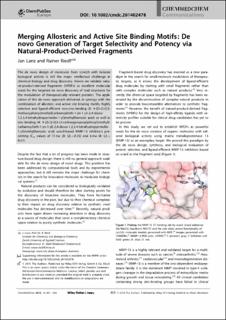Please use this identifier to cite or link to this item:
https://doi.org/10.21256/zhaw-1687Full metadata record
| DC Field | Value | Language |
|---|---|---|
| dc.contributor.author | Lanz, Jan | - |
| dc.contributor.author | Riedl, Rainer | - |
| dc.date.accessioned | 2018-02-16T14:56:30Z | - |
| dc.date.available | 2018-02-16T14:56:30Z | - |
| dc.date.issued | 2015 | - |
| dc.identifier.issn | 1860-7187 | de_CH |
| dc.identifier.issn | 1860-7179 | de_CH |
| dc.identifier.uri | https://digitalcollection.zhaw.ch/handle/11475/2862 | - |
| dc.description | Coverpicture: https://doi.org/10.1002/cmdc.201590003 | de_CH |
| dc.description.abstract | The de novo design of molecules from scratch with tailored biological activity is still the major intellectual challenge in chemical biology and drug discovery. Herein we validate natural-product-derived fragments (NPDFs) as excellent molecular seeds for the targeted de novo discovery of lead structures for the modulation of therapeutically relevant proteins. The application of this de novo approach delivered, in synergy with the combination of allosteric and active site binding motifs, highly selective and ligand-efficient non-zinc-binding (3: 4-{[5-(2-{[(3-methoxyphenyl)methyl]carbamoyl}eth-1-yn-1-yl)-2,4-dioxo-1,2,3,4-tetrahydropyrimidin-1-yl]methyl}benzoic acid) as well as zinc-binding (4: 4-({5-[2-({[3-(3-carboxypropoxy)phenyl]methyl}carbamoyl)eth-1-yn-1-yl]-2,4-dioxo-1,2,3,4-tetrahydropyrimidin-1-yl}methyl)benzoic acid) uracil-based MMP-13 inhibitors presenting IC50 values of 11 nM (3: LE=0.35) and 6 nM (4: LE=0.31). | de_CH |
| dc.language.iso | en | de_CH |
| dc.publisher | Wiley | de_CH |
| dc.relation.ispartof | ChemMedChem | de_CH |
| dc.rights | https://creativecommons.org/licenses/by-nc-nd/4.0/ | de_CH |
| dc.subject | Medicinal chemistry | de_CH |
| dc.subject | De novo drug design | de_CH |
| dc.subject.ddc | 572: Biochemie | de_CH |
| dc.subject.ddc | 615: Pharmakologie und Therapeutik | de_CH |
| dc.title | Merging allosteric and active site binding motifs : de novo generation of target selectivity and potency via natural-product-derived fragments | de_CH |
| dc.type | Beitrag in wissenschaftlicher Zeitschrift | de_CH |
| dcterms.type | Text | de_CH |
| zhaw.departement | Life Sciences und Facility Management | de_CH |
| dc.identifier.doi | 10.1002/cmdc.201402478 | de_CH |
| dc.identifier.doi | 10.21256/zhaw-1687 | - |
| zhaw.funding.eu | No | de_CH |
| zhaw.issue | 3 | de_CH |
| zhaw.originated.zhaw | Yes | de_CH |
| zhaw.pages.end | 454 | de_CH |
| zhaw.pages.start | 451 | de_CH |
| zhaw.publication.status | publishedVersion | de_CH |
| zhaw.volume | 10 | de_CH |
| zhaw.publication.review | Peer review (Publikation) | de_CH |
| zhaw.webfeed | Organische Chemie | de_CH |
| zhaw.webfeed | CC Drug Discovery | de_CH |
| Appears in collections: | Publikationen Life Sciences und Facility Management | |
Files in This Item:
| File | Description | Size | Format | |
|---|---|---|---|---|
| 2015_Lanz_Merging allosteric and active site binding motifs_ChemMedChem.pdf | 726.94 kB | Adobe PDF |  View/Open |
Show simple item record
Lanz, J., & Riedl, R. (2015). Merging allosteric and active site binding motifs : de novo generation of target selectivity and potency via natural-product-derived fragments. ChemMedChem, 10(3), 451–454. https://doi.org/10.1002/cmdc.201402478
Lanz, J. and Riedl, R. (2015) ‘Merging allosteric and active site binding motifs : de novo generation of target selectivity and potency via natural-product-derived fragments’, ChemMedChem, 10(3), pp. 451–454. Available at: https://doi.org/10.1002/cmdc.201402478.
J. Lanz and R. Riedl, “Merging allosteric and active site binding motifs : de novo generation of target selectivity and potency via natural-product-derived fragments,” ChemMedChem, vol. 10, no. 3, pp. 451–454, 2015, doi: 10.1002/cmdc.201402478.
LANZ, Jan und Rainer RIEDL, 2015. Merging allosteric and active site binding motifs : de novo generation of target selectivity and potency via natural-product-derived fragments. ChemMedChem. 2015. Bd. 10, Nr. 3, S. 451–454. DOI 10.1002/cmdc.201402478
Lanz, Jan, and Rainer Riedl. 2015. “Merging Allosteric and Active Site Binding Motifs : De Novo Generation of Target Selectivity and Potency via Natural-Product-Derived Fragments.” ChemMedChem 10 (3): 451–54. https://doi.org/10.1002/cmdc.201402478.
Lanz, Jan, and Rainer Riedl. “Merging Allosteric and Active Site Binding Motifs : De Novo Generation of Target Selectivity and Potency via Natural-Product-Derived Fragments.” ChemMedChem, vol. 10, no. 3, 2015, pp. 451–54, https://doi.org/10.1002/cmdc.201402478.
Items in DSpace are protected by copyright, with all rights reserved, unless otherwise indicated.